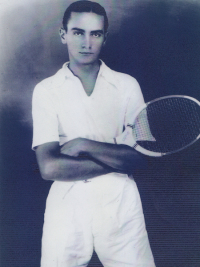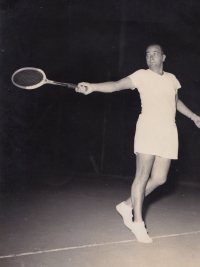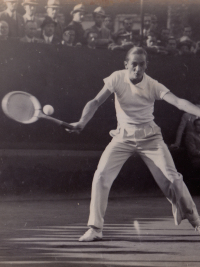Manuel Fernandez
Alias: Manuel Fernandes
Manoel Fernandes
Maneco Fernandes
| Born |
Subscribe now
This information and data is not available because you are not our subscriber yet.
Please click here and get full access to the entire database! |
|---|---|
| Died | |
| Plays | |
| Latest NEWS |
Frightened by his opponent's vigor, Urba went to the third most reshaped set. Still failed to hold back the momentum of Santos, who closed the score with a 6/3, signaling the devastating victory in favor of Brazil, drawing the serious against strong Czechoslovakia. The repercussion of Maneco Fernandes' triumph over Urba ran the world of tennis. In Santos, the news came with a huge party. All critics of the sport surrendered to the technical acuity of the Brazilian tennis player. Many said that other than the unfortunate episode of World War II, which paralyzed all sporting activities in Europe, Maneco would be one of the highest ranked in the category, due to his technical ability and dexterity. Czechoslovakia would eventually win the match against Brazil and eventually become the Davis Cup champion of 1948, beating Belgium on Wednesday; Italy in the semi and Sweden in the final, confirming the favoritism of the country in the tournament. Of all the games, the most remembered was the confrontation with the Brazilian Maneco Fernandes. A hard start Born on September 29, 1921, in the city of São Paulo, Manoel Fernandes, Maneco, had very early contact with the sport of rackets. His father, Jaime Fernandes, was a janitor in the 1930s of the trendy Clube Atlético Paulistano, an association that offered members some clay courts. His first contact with tennis came when he was six years old, in 1927, during the time when athletes went to the court of impeccably creased white pants. But Maneco didn't have the financial resources that other boys had. Therefore, his racket was different, simpler, made from the extracted wood, the saw, from a fair box. The handle, he wrapped with tape, so as not to hurt his hands. The boy was right-handed and had great power in top spin strikes (Topspin is a movement in the tennis game that runs from the bottom up, forehand or backhand racket, with the aim of spinning the ball, then , suddenly rise and fall within the opponent's court). Fernandes's youth was not easy, especially after the death of his father, who died when Maneco was still in his teens. So she had to take care of her mother and four younger brothers. When he was 15 years old, then President of Atletico Paulistano Club Antonio Prado Junior called him in a corner and said: "From now on, you will only play tennis, and with the club's salary." It was the door that Maneco needed to fly away without neglecting his family. The first title In 1939, Maneco received his first big break at the invitation of the famous Japanese tennis player Jiro Fujikura, who settled in Brazil after participating in a tournament in São Paulo, which was attended by Fernandes. That year there had been an earthquake in Chile, and the South American Tennis Confederation decided to hold a tournament for the victims. Jiro took Maneco with him and the young man surprised everyone, beating the then-Brazilian super champion Alcides Procópio, the best tennis player in the country and five years older than Fernandes. The victory was a crushing 3 × 0. Procopio later tried to justify the defeat by claiming to have been uneasy moments before the match. The truth is that Procopio would become Maneco's big rival, leading to the worst in most confrontations. In some interviews with the retired racquet press when asked about the confrontation with Procopio, he said, "We played a hundred and fourteen matches." And how many times have you lost? the reporters asked him. "Just one!" The 1939 title in Chile so excited the young tennis player that he began to sign up for several tournaments, including the national one. Throughout his long walk on the courts, Maneco not only won several titles, but also won several friendly games with big tennis names in his day. Out through the back doors One of Maneco's most memorable matches took place in Santos in 1948 against then Wimbledon tournament winner North American Bob Falkenburg (a curiosity is that he would become a successful entrepreneur in the fastfood world by creating the diner network). Bob's). In the Tennis Club courts, Maneco took no notice of the famous opponent and imposed a convincing 3 × 0. The game was so overwhelming that the embarrassed Wimbledon winner stepped out the back door of the Santos club. Maneco was definitely not a good host within the courts. He has brilliantly beaten the likes of North Americans Frank Parker (two-time US Open Champion 1944/1945 and Roland Garros 1948/1949) and Bill Talbert (No. 3 in the world ranking in 1949 and champion of tournaments like the US Open). But his greatest joy was to beat Argentina's hermanos, such as Enrique Moréa, with whom he played the longest match of his career, four and a half hours, on November 21, 1951, won by the Brazilian in the indoor court of Pacaembu Stadium. Morea was considered the best tennis player in South America at that time. Beating the Argentines was no easy task for Maneco, who early in his career embittered some losses. The secret of the path was handed to him by sports chronicler Adriano Zappa, a former tennis player and deep connoisseur of the Buenos Aires style. “You must improve your indoor game. Doing so will have a huge chance of winning. ” That's what Maneco did and did very well. A spectacular turn One of the most exciting matches of Maneco's career was undoubtedly against Ecuadorian Francisco (Pancho) Segura Cano, one of the biggest names in tennis history, in the late 1940s (He was No. 1 in the 1950s world ranking) . The game took place at Clube Atlético Paulistano, starting with 1 × 0 (7/5) balanced. Pancho won the second 6/0, demonstrating the Ecuadorian frank favoritism. Fernandes had played Pancho before and lost almost every time. “Play with Segura! He is a player who greatly disrupted his opponent on a tennis court. Because you never knew if he was going to drive or leave. He played with both hands. Few players in the world had a right like his. Then either a paula came or a left. And when they were left, they were the ones that dripped there, stuck in the net, ”Maneco said in a 1976 interview about his career. Thus, following the writing, the third set was already heading for the outcome in favor of Segura Cano, 5 × 1 (40/15 in the last game). Only one point left. It was then that Maneco inadvertently did something that would change the course of the match. Well, I'm going to hit the ball and send it to the side of Rua Argentina - which was at the back of the Paulistano Club - and end this game, he thought as Pancho pulled the mach point. It turns out that instead of disappearing among the trees at the back of the club, Maneco's powerful left came in favor of the Brazilian, who was filled with desire and set off for a historic turn. The Santos player tied the game, won the set by 7/5 and the following by 6/2 and 6/3, in an electrifying match, which lasted over three and a half hours. Maneco, coffee broker, good cup and fork Maneco married his beloved Beth (Elizabeth of the Kings Portela Fernandes), with whom he had a son (Adelson Portella Fernandes). As tennis did not provide him with the necessary support to take care of his family, he decided to enter the coffee trade, becoming a broker in the city of Santos, a place that already had strong ties. So he took turns in his tennis career with his coffee trade profession. His love of tennis was so immense that even after leaving the national circuit, he began training young athletes and playing in the veteran categories, where he also won many titles. But Maneco also enjoyed other passions, such as collecting whiskeys and wines. The tennis player, however, hated beer. And before a good glass he was an excellent cook, usually summoned to the stove by his tennis friends. Maneco moved with imagination and rigor from bean stew to codfish. Maria Esther Bueno's Fan When talking about tennis, already retired from the courts, Maneco said he was an unconditional fan of Maria Esther Bueno (Brazilian tennis player of the 50/60/70 who won nineteen Grand Slam tournaments - 7 in the single category, 11 in women's doubles, 1 in mixed doubles, according to the International Tennis Federation, was No. 1 in the world in 1959 in the women's individual category). On the male side, he said the biggest Brazilian of all was Ronald Barnes (the only one in Brazilian men's tennis to arrive in a Grand Slam semifinal to Gustavo Kuerten). Maneco even saw Guga (Kuerten) play and was delighted to see Brazilian tennis at the top of the world list. He also saw Jaime Oncins, Thomas Koch, Carlos Kirmayr, Niege Dias, Marcos Hocevar, Luiz Mattar and Fenando Meligeni. But what he wanted was to see his son, Adelson, also shine on the courts. But although the goldfish did not follow in the footsteps of the father fish, Maneco was proud of his son, who became a first-rate lawyer. “They say that when we only have one child, he gives a headache. Lie. Mine only gave joy! ”He said in interviews. Manoel Fernandes died on November 19, 2003, leaving a huge legacy of achievements, examples and putting the name of the city of Santos in the roll of the largest in the country in tennis.">Click here to read latest news on |
| Bio | He had very early contact with the sport of rackets. His father, Jaime Fernandes, was a janitor in the 1930s of the trendy Clube Atlético Paulistano, an association that offered members some clay courts. His first contact with tennis came when he was six years old, in 1927, during the time when athletes went to the court of impeccably creased white pants. He was Brazilian champion in 1947. He represented Brazil in Davis cup in 1948 against Czechoslovakia, winning his singles match versus Ferninand Vrba and retiring versus Jaroslav Drobny, plus he played a doubles match along with Ernesto Petersen. |
| Tournament | AO | RG | W | US | Win-Loss |
|---|---|---|---|---|---|
|
Subscribe now
This information and data is not available because you are not our subscriber yet.
Please click here and get full access to the entire database! |
|||||



